Atlantic Monthly Contributors's Blog, page 101
August 12, 2016
The Unsporting Spirit

NEWS BRIEF One major theme of the Olympic mythology is the tradition of the Olympic truce. The truce can be traced back to ancient Greece of the 9th century BC, when those at war were implored to stop fighting in honor of sport. Adapted for a more modern context, Olympic athletes are now beseeched to “use sport to establish contacts between communities in conflict” and “create a window of opportunities for dialogue and reconciliation.”
But failing all those progressive aims, there’s always the baseline aspiration of a truce, which translates from Greek literally as the “holding of hands.” On Friday, that basic spirit was undercut at the Games in Rio when, following a judo match, Islam El Shehaby of Egypt refused to shake hands with Or Sasson, his Israeli opponent. Combining the Olympic standard with the post-match tradition of bowing in martial arts, this made for a very public rebuke:
Classless Egyptian competitor refuses to bow or shake hands with the Israeli who beat him. #Judo #isr #EGY #Rio2016 pic.twitter.com/GZ4S2wNxVW
— Tim Young (@TimRunsHisMouth) August 12, 2016
While El Shehaby, who was loudly booed by the crowd in Rio, this was hardly the first episode highlighting contentious relations between Israel and its neighbors at the Games in Rio or in previous years. Earlier this week, a Saudi judoka was thought to have withdrawn from a match that would have eventually pit her against an Israeli opponent and a Lebanese Olympic delegate was reprimanded for blocking Israeli athletes from boarding a bus to the Games’ opening ceremony.
Egypt and Israel had what most observers call a “cold peace” since the landmark Camp David Accords normalized relations between the two countries in 1979. Nevertheless, the International Judo Federation deemed Friday’s match to be a sign of progress. “This is already a big improvement that Arabic countries accept to (fight) Israel,” said one spokesman. He added the incident would be reviewed and that El Shehaby, who was pressured by some in his country to withdraw from the match, may face punishment.

Rocked By Turbulence

NEWS BRIEF A JetBlue flight conducted an emergency landing Thursday after the plane experienced turbulence so bad that 22 passengers and two crew members were sent to the hospital.
Flight 429, which was flying from Boston to Sacramento, was forced to divert to Rapid City, South Dakota, after it was determined some passengers required medical attention.
Derek Lindhal, a passenger on the flight, tweeted saying he saw passengers lifted off their seats and into the air, causing several injuries.
Flight attendant was in galley during incident. Hit her head on ceiling & completely dislodged the panel. Cuts, neck injury, and concussion
— Derek Lindahl (@oif_vet) August 12, 2016
Though JetBlue did not give a reason for the turbulence, it is believed that thunderstorms played a role. CNN has more:
The plane encountered a line of thunderstorms in central South Dakota, according to a flight path analysis by CNN meteorologists Monica Garrett and Chad Myers. After passing through a first storm, the plane came upon a second, which the pilot attempted to fly over or around. The significant turbulence was likely caused by one or both storms.
"While some turbulence can't be detected on radar, this was not that kind," said Brandon Miller, a producer with CNN's World Weather team. "This turbulence was caused by the rapid rising of air inside the thunderstorms."
This isn’t the first time JetBlue passengers have experienced injury due to turbulence. Eight passengers were injured in May when turbulence rocked a plane traveling from San Juan, Puerto Rico, to Orlando, Florida.

The Olympic Quote (That Should Be) Heard ‘Round the World
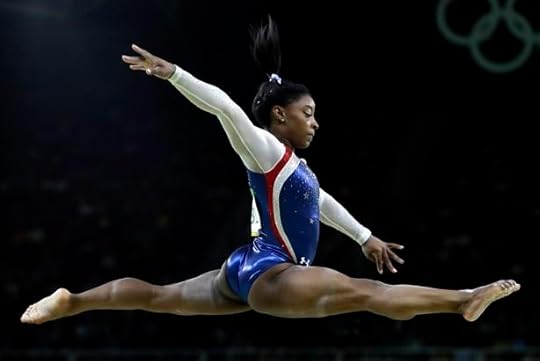
After winning individual gold in the women’s gymnastics all-around on Thursday, Simone Biles, in an interview, made a declaration. “I’m not the next Usain Bolt or Michael Phelps,” she said. “I’m the first Simone Biles.”
It was a simple tautology—of course she’s the first Simone Biles—that was also a powerful response to the gendered double standards that have so far plagued the 2016 Games. She’s not a lady version of a guy; she is … herself. It was an obvious point that, given some of the media coverage of Rio, was also a powerful piece of media criticism.
The coverage of women’s gymnastics has a long tradition of emphasizing the contrasts of its competitors: traditional girlishness on the one hand, traditionally masculine qualities—“power” chief among them—on the other. And NBC’s gymnastics commentators (under a mandate from NBC to address themselves to a notional “Madeleine in Middle America, who doesn’t know gymnastics”) have reveled in those easy contradictions. Biles stands, they have emphasized, at only 4 feet, 8 inches tall. She giggles a lot. A promotional package NBC aired during Rio’s women’s gymnastics qualifying round featured Biles’s parents talking about her love for shopping. It also showed her getting a manicure.
NBC has presented Biles’s femininity as, for the most part, an Interesting Contrast to her athleticism.
NBC has presented, in other words, Biles’s displayed femininity—her giggle, her sparkly leotard, her love of things that are traditionally girly—as an Interesting Contrast to her athleticism, as if the existential collision between the two were simply one more thing that Biles, with her superhuman abilities, has transcended. Look at that girl do all that! She’s powerful like Michael Phelps, but a girl!
But it’s not just Biles who’s faced subtle double standards as the Rio Olympics have played on. NBC’s anchors, looking upon the most talented U.S. women’s gymnastics team ever assembled, noted of its members’ sidelines chit-chat that “they could be standing in a mall.” The Chicago Tribune announced the fact that the U.S.’s Corey Cogdell-Unrein had medaled in trap-shooting with the tweet, “Wife of a Bears’ lineman wins a bronze medal today in Rio Olympics.” When the Hungarian swimmer Katinka Hosszú won a gold medal (breaking, in the process, a world record) in the 400-meter individual medley, The Cut reports, “the camera panned to her husband.” At which point NBC’s commentator intoned, “and there’s the man responsible.”
And then there was The Daily Mail, announcing Katie Ledecky’s multiple Olympic wins by referring to her as “the female Michael Phelps.”
And then—oh, and then—there was NBC, explaining its decision to air tape-delayed versions of Olympic events with the following declaration:
The people who watch the Olympics are not particularly sports fans. More women watch the games than men, and for the women, they're less interested in the result and more interested in the journey. It’s sort of like the ultimate reality show and mini-series wrapped into one.
The strange gendering of much of the Olympics coverage so far has prompted what you would expect it to: indignant excoriations of Olympic sexism, guides on how to avoid falling victim to Olympic sexism, cheekily gender-flipped headlines—“Michael Phelps, the Male Katie Ledecky, Just Made Olympic History”—that make a point about the double standards by reveling in them. These are all, to be sure, valuable efforts to reclaim the old “she throws like a girl” insult for an age of (increased) gender parity, and to turn that insult into what it should be: a compliment.
But on the Olympic stage, no one has a more powerful voice than an athlete herself. And that was just one more way, on Thursday, that Simone Biles accomplished something big. She’s not the next Michael Phelps, she insisted. She’s not the next Usain Bolt. “I’m the first Simone Biles,” she declared. And nothing more needed to be said.

Who Is Leonidas of Rhodes?

NEWS BRIEF Leonidas of Rhodes had a good run as the greatest athlete in the world, as far as most individual wins in Olympic competition go. His record lasted 2,168 years, until this Thursday.
Michael Phelps won his 22nd gold medal in the 200-meter medley at the Rio Olympics, which makes for 13 individual career golds, a feat that put him ahead of Leonidas’ record set in 152 B.C.
#Olympics Phelps 13 Leonidas 12. Hard luck Leonidas but the 2168 year old record has gone https://t.co/5wE361aPjT
— Hilary Evans (@OlympicStatman) August 12, 2016
Back then champions didn’t receive medals. They were given wreaths from wild olive trees, and Leonidas had more than anyone else. He won three events—called a Triast—at four consecutive Olympiads, which made for 12 individual wins, his last at age 36 (Phelps is 31). Leonidas was a runner and he competed in the stadiun, a 200-meter sprint, the diaulos, which was 400 meters, and the hoplitodromos, the same as the diaulos, except it’s run while wearing a helmet, greaves, and while carrying a bronze-and-wood shield.
The BBC interviewed a historian, who said of Leonidas that:
“He broke through the distinction between sprinters and endurance athletes,” says Paul Cartledge, professor of classics at the University of Cambridge. The race in armour had not previously been considered suitable for sprinters (the Olympiads had already been going for a few centuries).
“They were running in armour, the temperature would be 40C. The conditions were fantastically unpleasant, requiring completely different muscles and gymnastic skills.”
Leonidas’ accomplishments made him almost godlike, because ancient Greeks venerated athletes as people now do movie stars. Not much else is known about Leonidas, but it’s a tribute to his accomplishments that people are still talking about him today—and he did it all, as far as we know, sans cupping.

The Reason Suicide Squad Is Crushing? People Love It
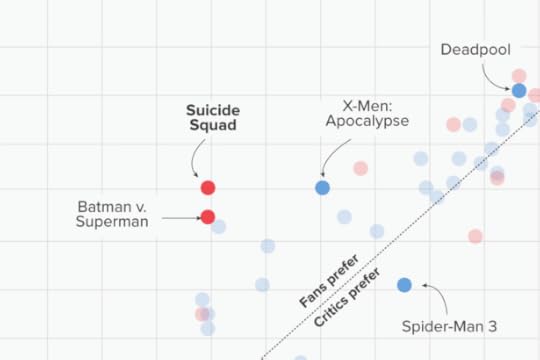
So hold on: Is Suicide Squad good or bad? Bad, right? I haven’t seen it, but I’ve sat through the preview roughly a dillion times this year, and Jared Leto’s cackling psycho hipster routine did not improve with repetition. When the film scored a horrible 26 percent on Rotten Tomatoes, I figured I was in the clear—OK, bad movie, don’t have to see it, back to waiting for Black Panther.
But somehow, this bomb banked $133 million in its opening weekend. Not only does that total beat the better-reviewed Deadpool (84 percent on Rotten Tomatoes), which I loved, it smashed the August box office records previously set in 2014 by Guardians of the Galaxy, which I really loved. And this doesn’t seem to be a fluke: Deadline reports Suicide Squad is posting great weekday numbers, beating even the vaunted Captain America: Civil War for a Tuesday box-office record. Hence my confusion. How could such a poorly reviewed film make so much money?
Here’s the secret: People actually love it.
Movie critics and popular opinion often sync up pretty closely. But in the case of Suicide Squad, regular folks took a hard left. While three-quarters of reviewers gave the movie a bad review, almost the same percentage of Rotten Tomatoes users gave it a thumbs up. Their average rating was 7.4/10, compared to the critics’ 4.7/10. The experts panned the flick. The fans loved it.
Is this unusual? To find out, I pulled the 50 or so top-performing Marvel and DC films, as measured by opening weekend box-office revenue. I compared their Rotten Tomatoes scores, pitting reviews from critics against ratings from users.
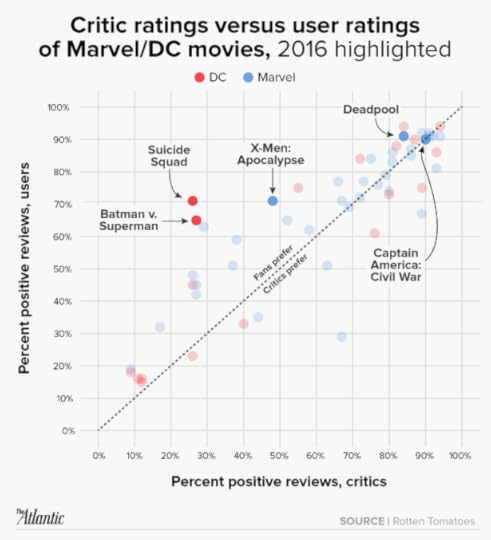
Suicide Squad is not just an outlier. It is the outlier, boasting a gap of 45 percentage points between reviewers and users, the largest in this sample. Second place goes to—surprise!— Batman v Superman, another critically panned sort-of-blockbuster that just so happens to be the prequel to Suicide. Among the 2016 flicks, only Deadpool and Captain America: Civil War were equally loved by critics and fans alike. (Here’s a larger version of this graphic with all the points labeled.)
This love-hate relationship goes both ways. Critics were far more complimentary than fans of 2004’s Hulk, with two-thirds giving it their blessing. I personally remember that movie for its interminable length and lack of memorable smashing. Moviegoers apparently agree with me, with only 29 percent giving it a positive review. Critics and fans were similarly split on 2002’s Spider-Man, starring a boyish Tobey Maguire, which earned a startling 89 percent of critical favor but only 67 percent among the plebeians. (Don’t confuse it with The Amazing Spider-Man, which featured a Shia LaBeouf-ish Andrew Garfield. Everyone agrees that one was just OK.)

To be fair, fans who write amateur reviews of superhero movies might be a teensy bit biased. Averaging the positive user-review percentages, I found Rotten Tomatoes contributors are five percentage points more likely than critics to give one of these films a positive review, probably because they’re the sort of people who want see costumed megahumans punch things to begin with. Even so, Suicide Squad sets a striking record. It is almost certainly the biggest disagreement between critics and moviegoers over a Marvel/DC movie to date.
We’ve seen this split before. Remember The Boondock Saints, that bizarre Catholic twins revenge rampage that spawned a million dorm-room posters? Fans loved it—91 percent on RT—and critics hated it—20 percent. But the size of Suicide’s haul is what sets it apart. With more than $100 million already in the bank, I wouldn’t be surprised if it beat Batman v Superman’s domestic take of $330 million. Cult classics are one thing—bad movies that tank at the box office but live on forever in well-worn DVDs. Suicide Squad looks to be an actual smash.
How many things will the elites get wrong? Donald Trump, Brexit, and now this? The thing is, I have no doubt that Suicide Squad sucks. Movie reviewers are a savvy bunch, and not all of them are holding their noses in the air and thirsting after the next Werner Herzog documentary. They’re sensible people who want to keep you from seeing bad movies. Problem is, bad movies are exactly what people sometimes want. So let’s dispense with our surprise that Suicide didn’t spontaneously combust in the 4,255 theaters that screened it. The market has told us what the reviewers couldn’t: People enjoyed this movie. So let them.

The Get Down and the Sanctuary of Hip-Hop

After a deadly shooting at a T.I. concert in New York City earlier this year, the NYPD commissioner William Bratton gave a radio interview blaming the bloodshed on “the crazy world of these so-called rap artists who are basically thugs” who “basically celebrate violence they did all their lives, and unfortunately that violence oftentimes manifests itself during their performances.”
This is old, familiar allegation against the genre, one that not only blows by questions of correlation and causation and confirmation bias but also refuses to separate out an art form’s content, purpose, and the social conditions within which it has been made to flourish. For decades, rap has been portrayed as especially dangerous because of the music itself—even more so than rock and punk and jazz, though they all, at one point or another, were accused of having a corrupting and deadly influence.
So it was even for disco, as Baz Luhrmann’s bighearted and halfway successful new Netflix series The Get Down reminds its viewers early in its run. Set mostly in ’70s Bronx, it centers on the high-school student Ezekiel (Justice Smith), who, we can assume, will one day be the rap superstar performing at the 1996 Madison Square Garden concert shown at the start of each episode (with Hamilton’s Daveed Diggs lip-syncing to lyrics from executive producer Nas). But hip-hop doesn’t exist for Zeke in 1977, and it barely exists for anyone else either. Instead, there’s disco, which his neighborhood crush, Mylene (Herizen Guardiola), wants to conquer as the next Donna Summers. Unfortunately, Mylene’s dad (Giancarlo Esposito) is a strict minister who literally considers it the devil’s music. “Thy voice shall only be lifted to the glory of god,” are his first words on-screen.
From everything The Get Down then shows us—spoilers for the premiere ahead, though this isn’t a show you really watch for plot—he’s not necessarily wrong to worry about his daughter’s disco fever. The club she sneaks out to is called “Les Inferno,” for starters. Her efforts there to hand a demo tape to an influential DJ trigger a flamboyant crime enforcer named Cadillac to make sexual advances on her. And the Get Down’s first transcendently giddy musical sequence, a hustle-and-point duel to C.J. & Co.’s “Devil’s Gun,” meets its disturbing end when a group of masked men shoot up the club.
But once the violence erupts, the groove fades and distorts and Luhrmann’s soundtrack cuts to opera more befitting a Godfather showdown: one of many tells that in this show’s colorful take on cultural history, bloodshed and strife exist not in cahoots with the music of a marginalized and economically bereft minority but in tension with it. Standing near rubble-strewn vacant lots and burning buildings in the Bronx, Les Inferno and the gambling club above it are a playground for brown and black folks (one of whom, the delightfully imperious mob boss Fat Anne, runs the place). A bouncer outside tells Zeke to go around the corner when it appears he’s about to enter a fistfight. And the awful massacre is perpetrated by a gang called the Savage Warlords, white youths dressed like the cast of The Warriors. The disco club, it’s clear, is shaped by the presence of violence and desperation. But it’s also meant to be a refuge.
The same could be said for all of the creative exploits that the utterly charming kids of The Get Down get up to, including graffiti writing, DJing, breakdancing, and emceeing, the canonical four pillars of hip hop. By the end of the hour-and-a-half premiere, Zeke and his buddies have attended the titular Get Down, a party where Grandmaster Flash (Mamoudou Athie) shows off his radical new technique of using turntables to create a continual rhythm from parts of other peoples’ songs. Earlier, Zeke rebufffed his English teacher’s encouragements to use his talent for poetry in order to escape from the life that the Bronx would otherwise impose on a young, poor, parentless male like him. It’s only at the the Get Down, where the braininess that gets made fun of in the classroom can become a social weapon and route to status, that he takes his first step to rap stardom.
Which is not to say that discovering hip-hop magically whisks him away from the perilous dynamics of his environment—an environment clearly shaped by government neglect, as shown by an interwoven plotline about Mylene’s uncle, a tough but community-minded political boss played by Jimmy Smits. During the chaos-causing NYC blackout of ’77, Zeke considers joining the looting so as to help move his dream along, but a buddy counsels him to fall back. “Why, because we’re special?” Zeke asks. “Because we’re above all of this? How are we above all of this?”
* * *
Famous for Moulin Rouge, Romeo + Juliet, Australia, and 2013’s Great Gatsby, Lurhman hasn’t tamped down his more-is-more instincts for The Get Down. The camera twirls like a disco ball, glinting out storylines about artistic ambition, teenage love, urban politics, crime, and the record business. It’s clear we’re in the realm of the mythic when the graffiti artist and aspiring DJ named Shaolin Fantastic (Shameik Moore) arrives in montages of parkour and kung-fu sound effects. Sometimes there’s a sensation of entering a Shakespeare adaptation when Ezekiel breaks into rhyming dialogue with other characters. Often, the actors will wear facial expressions of Grease-like exaggeration. But we’re meant to feel grounded in historical reality, too, as telegraphed by Luhrmann’s liberal use of grainy documentary footage of ’70s New York City and Ed Koch’s tough-on-crime mayoral campaign.
Netflix and Sony Pictures Television spent a scandalous $120 million on the show, and it’s paid off in the sense that sparkle and flash are the most successful components of The Get Down’s entertainment factor. Which is a nice way of saying that the plotting of the three episodes I’ve seen would not hold anyone’s attention on it’s own. You like the characters but rarely feel any great suspense as contrived obstacles crop up to to complicate but not derail their journeys. This could prove fatal for the show’s chances to do what a Netflix hit needs to do, compel viewers to not hit the “X” button between episodes.
The Get Down works like a song whose lyrics are mind-numbing but whose beat can’t be denied.
But for many people, The Get Down may work like a song whose lyrics are mind-numbing but whose beat can’t be denied. Luhrmann’s aesthetic flights of fancy and the show’s fertile premise count for a lot. So does the extremely appealing cast, which includes recognizable faces like Jaden Smith, Esposito, and Smits but thrives most on its unknowns. Justice Smith as Ezekiel is particularly magnetic—he’s a scrawny kid who talks like Rocky Balboa, and the moments when his low-and-rumbly shtick becomes ridiculous, like when he grunts out a declaration of love to Mylene, are all the more endearing. You want to spend time in this film universe, even if you don’t care all that much what’s happening on a scene-to-scene basis.
An undertaking like this, with the white Aussie Hollywood power player Luhrmann stylizing a history and culture far from his own, is an obvious minefield, and no doubt there are ways in which he has not navigated it fully. But the contributions of the journalist Nelson George in the writer’s room and Grandmaster Flash and Nas as producers may have helped prevent there from being too many cringeworthy moments of insensitivity (though viewers may cringe for other reasons during Luhrmann’s hammier scenes).
On the press tour before the show’s premiere, Grandmaster Flash has helped give insight into the reality that The Get Down so eagerly bedazzles. Talking to The Guardian about one of his Bronx block parties, the kind of Zeke and friends attend, he recalled, “The police officers loved us. You could see them parked across the street. They don’t have to chase no thugs because the thugs are in the park with us jamming. So we made their job easy.” And when walking in hostile gang territory back then, “It was like, ‘Oh that’s Grandmaster Flash, let him go. … They respected what I did.” So it’s really not just TV-show mythologizing when The Get Down presents music as a way to try and survive danger—exactly the opposite of how some people, even today, think of one of our era’s most vibrant art forms.

August 11, 2016
France's Call for Refugee Hosts
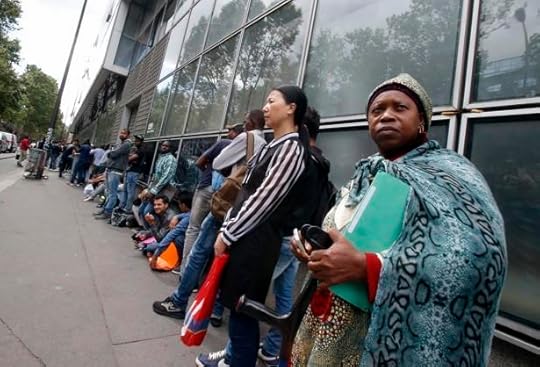
NEWS BRIEF The French Ministry of Housing and Sustainable Homes says it will pay 1,500 euros to organizations for each refugee they help to house, as the country’s migrant centers are overcrowded.
Hébergement citoyen des #réfugiés : @emmacosse lance un appel à projets pour les associations, ouvert jusqu'au 20/09 https://t.co/dkaVW6QDRe
— Ministère Logement (@Logement_Gouv) August 10, 2016
“Citizens hosting #refugees : @emmacosse calls for organization’s projects, open until 09/20,” the ministry tweeted.
Emmanuelle Cosse, the housing minister, released a statement Tuesday urging French organizations to submit “citizen engagement” proposals to help coordinate the housing and integration of incoming refugees. She said:
As part of the European agreements, France will receive more than 30,000 refugees from Turkey, Lebanon, and from hot spots in Greece and Italy in 2017. And millions of others will arrive on their own to apply for asylum in France. … This call for citizen housing would support and accompany civil society's goals and welcome an additional 1,000 refugees within an experimental and innovative initiative.
To accommodate the expected refugee influx, the ministry announced plans to more than double the capacity of refugee centers from 2,000 spaces to 5,000 spaces by September, Le Monde reports. An estimated 500 refugees have already been placed with French families, and Tuesday’s proposal aims to increase that number by 1,000.
“It is a great way to build relationships and create a network, but there are safeguards, to ensure accommodations are in good condition, that it’s free, and that it’s not overly burdensome for the families,” Cosse told Le Monde.
Organizations interested in the project must be able to coordinate housing for 50 or more refugees, as well as find hosts who can provide private rooms for a minimum of three months. The organizations must also provide legal resources and emergency support. In return, the government has offered to provide the organizations with monetary incentives of up to 1,500 euros per refugee per year.
Far-right group have criticized the proposal with Marion Le Pen, a lawmaker from National Front, tweeting against the program, implying that the minister is asking citizens to harbor refugees.
In response, Cosse tweeted, “Welcome, solidarity: French traditions @Marion_M_Le_Pen ignores but many practice. Proud to support.”
The French government has reaffirmed calls to accept refugees, pledging to accept 30,000 within two years, despite calls for the EU’s borders to be closed following recent terrorist attacks across France that have killed more than 200 people since 2015.

The Second Kenyan Banned From Rio

NEWS BRIEF A coach for Kenya’s Olympic running team has been sent home from Rio de Janeiro after he allegedly posed as an athlete to help cheat a doping test, according to several reports.
The coach, John Anzrah, is the second Kenyan official to be turned away from the Olympics over allegations tied to doping.
Reuters reported Anzrah’s actions on Thursday, citing a named official with Kenya’s National Olympic Committee:
"We have sent (sprint coach) Anzrah back home. He presented himself as an athlete, gave the urine sample and even signed the documents. We cannot tolerate such behaviour," Kip Keino, chairman of the National Olympic Committee of Kenya (NOCK), said in a telephone interview from Rio.
The Star, a Kenyan newspaper, also reported that Anzrah had tried to fool Olympic doping officials, although the paper credited unnamed sources:
Sources from Rio say Anzrah, the 1987 IAAF World indoor and IAAF championship runner, was caught by doping control officers who discovered a mismatch of his face and the photo on a badge he had worn.
The accreditation badge was that of an athlete who was scheduled for a random doping test. The sources confirmed the coach will be returning home Friday, August 12.
This is the second Kenyan official to be sent home. Last week, the country’s track and field manager, Michael Rotich, returned to Kenya after he was reportedly caught asking for a bribe in exchange for protecting athletes from drug testing authorities.
The Olympics this year have been plagued by doping scandals, beginning with the allegations the Russian government helped its athletes cheat doping tests in the 2014, followed by full ban on all the country’s track-and-filed athletes.

Parsing Obama's Sexy, Sometimes Woke Summer Playlist

Barack Obama has always been a slow, patient politician, sometimes infuriating allies and adversaries alike with his deliberate decision-making process. It’s that sort of mindset that leads to the president releasing his summer playlist only now, with August halfway over and back-to-school sales in full swing.
Nonetheless, the first family is off to Martha’s Vineyard, and so this is the time for Obama to share what he’s listening to—or perhaps more likely, what he’s “listening” to. Politicians’ playlists, as I’ve written before, may in some way reflect the tastes of their candidate, but they’re also fundamentally signaling mechanisms, intended to send a message. His 2012 campaign playlist, for example, was a carefully selected range of genres and ages, but it notably omitted any rap. The political playlist serves the same function as making a mixtape for a crush: You’re going to choose things you like, of course, but you’re also trying to impress the person you’re giving it to, and convey a certain image of yourself.
Last year’s playlist was, with all due respect, a tremendous snooze. Obama larded up his list with great but familiar artists (the Temptations, Sly and the Family Stone, the Isley Brothers, Stevie Wonder), often choosing the most obvious cuts (“Tombstone Blues” for Dylan, “Gimme Shelter” for the Stones. Lay off the Scorsese, Mr. President). There was an obligatory Chicago blues number, Howlin’ Wolf’s “Wang Dang Doodle.” There was some boring newer music (Coldplay, John Legend) and some more interesting but not especially edgy newer music (Okkervil River, Florence and the Machine). An evening list was full of other solid but uncreative choices, from Van Morrison to Frank Sinatra, Ray Charles to Al Green. The presence of the Lumineers was worth several demerits.
I’m happy to report that this year’s playlist is an improvement. And based on some of the unusual choices here, maybe a lame-duck president is letting his increasingly gray hair down and just picking what he wants to hear. The president has once again split his selections into daytime and nightime sections. He announced it via tweet, but for legibility, here are the two lists:

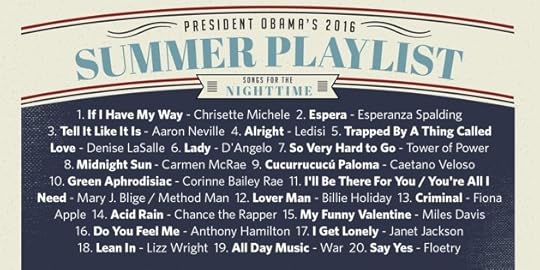
Side 1—to continue the mixtape metaphor—is a little more interesting than last summer’s nappable selection. Once again, it’s heavy on soul, R&B, and hip-hop, with choices that aren’t all that surprising. There’s Wale, who has managed to get invited to the White House repeatedly for no clear reason other than being from D.C., and Common, another emcee with repeat executive-mansion stops. There are tracks from Obama campaign supporters Janelle Monae and Jay Z. Alas, the Hova track is from 2009’s Blueprint 3; it would have been fascinating if Obama had picked, say, “Spiritual,” the Black Lives Matter-themed song Jay dropped this summer.
There’s some obligatory Prince. This year’s blues number is from the young guitarslinger Gary Clark Jr., which is nice. Obama wins points for choosing the bassist Charles Mingus’s “II B.S.” rather than the usual Miles, Trane, or Duke for the jazz slot. For some reason, the president included “Good Vibrations,” and either he forgot he’d included it last year or he just really loves Aretha’s “Rock Steady.” The pleasant surprise here is “Elevator Operator,” the breakout hit from the deadpan, rough-edged singer-songwriter Courtney Barnett. Obama’s just another middle-aged man in D.C. taking his musical cues from Bob Boilen, evidently.
Side 2, though, the nighttime set, though … hoo boy. This is steamy stuff. It’s also, it must be said, actually good. Last year’s playlist, or even the daytime half this year, are the sort of thing you might put during a multigenerational barbecue: There’s something that’s at least acceptable for people of all ages, and nothing that’s going to offend anyone. But this bunch is something you might actually just put on to listen to, probably with a romantic partner.
It’s stacked: Aaron Neville. Ledisi. Tower of Power. Janet Jackson. D’Angelo. Corinne Bailey Rae. Mary J. Blige. Is it fresh? Not especially. Aaron Neville and D’Angelo both have new or recent albums (something from the latter’s Black Messiah would be another interestingly provocative choice, but oh well), but the tracks here are from the archives. The jazz bassist and singer Esperanza Spalding (you remember her—the one who beat Bieber for best new artist at the Grammys) has a critically acclaimed disc out as well, but it’s not represented here. You also won’t see anything from Lemonade, the biggest album of the year, but then it wouldn’t fit that well with the theme. (Nor is there anything from The Life of Pablo, whose auteur Obama famously once called “a jackass.”)
There are several intriguing picks, though. Caetano Veloso’s “Cucurrucucu Paloma” is an offbeat choice but a good one. Including Lizz Wright is a nice gesture, too—not as well known as some of the other artists, but fits in beautifully. Who would have picked out the president as a Fiona Apple fan? Finally, there’s Chance the Rapper’s “Acid Rain.” As a Chicago emcee, Chance is a logical selection. Still, he was surprised:
I'm honored that our President would include in his summer playlist BUT THE FACT THAT HE PICKED ACID RAIN
What's Wrong With Mr. Robot?

The following post has spoilers for the most recent episode of Mr. Robot .
“What’s happening? Where are we going?” asks Elliot Alderson, hacker extraordinaire and one-half of the personality known as Mr. Robot. He’s sitting in the backseat of a convertible with his sister, Darlene, who’s playing a video game in which Elliot is being beaten up by mobsters. Everyone in the car—Darlene, Elliot’s mom, his dead dad—cracks jokes about cancer and domestic abuse and despair, while canned laughter swells around them. There’s someone in the trunk, yelling. There’s a cameo by ALF. Someone is casually, graphically, murdered. Elliot can do little but look around wildly as the absurdity of his ’80s sitcom nightmare grows and grows.
Mr. Robot’s second season has regularly offered lines that serve as obvious meta-commentary. So it’s no surprise that Elliot’s questions from Wednesday’s bizarre fifth episode, “eps2.4_m4ster-slave.aes,” pretty neatly capture what was so spectacular about the show’s first season, and why the second has so far been an overwrought jumble. Last year, Mr. Robot regularly prompted viewers to ask themselves, “What’s happening? Where are we going?” but it was in the spirit of excitement, of willing to be swept away by the creator Sam Esmail’s mesmerizing directing, Elliot’s genius and foibles, and ambitious storytelling. Wondering the same in season two has felt much less satisfying; the questions often feel borne of confusion and frustration and boredom, rather than curiosity or suspense. At the halfway mark of its second season, Mr. Robot has unfortunately succumbed to so many of the mistakes that it elegantly avoided last year—narrative sprawl, unchecked pretentiousness, and a lack of momentum and cohesiveness.
The show still has plenty of ambition, as indicated by the aforementioned 17-minute opening sequence, which felt as though it had been written with “Too Many Cooks” on repeat. At first, the scene recalled some of season one’s audaciousness: Think of the brilliant dream sequence where Elliot and Angela ate fish in an office-restaurant hybrid, server lights blinking in the background. But where that earlier scene knew when to pull back, when to let moments linger just long enough, Wednesday’s sequence seemed to luxuriate in its own weirdness past the point of narrative or artistic usefulness.
It played up the horror of Darlene’s mom sticking a lit cigarette in her arm before punching her unconscious to a raucous laugh track, of Angela pausing to smile at the camera for her sitcom intro before continuing to sob next to her mom’s casket, of Elliot’s dad coughing up blood into his hand. And it all went on for 17 minutes. It was later revealed that Mr. Robot (Christian Slater) had taken over Elliot’s consciousness in order to protect him from the violent beating he was receiving at the hands of Ray’s (Craig Robinson) goons.
Such formal and tonal experimentation can be hard to come by on TV, especially on basic cable (though the likes of FX are changing that), so on some level Esmail and USA deserve credit for breaking with formula so imaginatively. But the scene also distills the kinds of excesses Mr. Robot has been especially prone to this season. Last year, the show displayed a knack for teasing out new mysteries and subplots while putting old ones to rest, all while pursuing its main thread: F Society’s attempt to take down E Corp. This year has been filled with so many apparent digressions (the Seventh Seal-esque chess match, countless Philosophy 101 soliloquies about the nature of reality and truth, Joanna Wellick’s romantic life, Whiterose’s sartorial interests), that it’s often unclear what kind of a story Mr. Robot wants to tell anymore. Rather than resolving some mysteries from season one (where is Tyrell?) the show is simply offering answers to questions few people were asking (“Who exactly thought of the name ‘Mr. Robot’?”)
The show didn’t need to reinvent or outdo itself—it needed consistency.
It doesn’t help that for much of season two, characters were so scattered that their storylines rarely intersected in meaningful ways. Only recently have a few converged: Angela and Darlene are now working to hack the FBI in order to hide their involvement in the downfalls of AllSafe and E Corp. Elliot is helping out as best as he can when he’s not engaged in various existential and ontological struggles. The FBI Agent Dom DiPierro (Grace Gummer) is digging around in Angela’s business. When characters do meet, their dialogue often borders on overwritten (See: Any Mr. Robot screed) or just plain goofy (“Control is about as real as a one-legged unicorn taking a leak at the end of a double rainbow.”)
All of which is to say that, right now, Mr. Robot is at risk of being remembered as one of those shows with a stellar first season that couldn’t quite keep the magic for season two. Notable examples include UnREAL, True Detective, Twin Peaks, and The Walking Dead (which eventually regained its footing for a while). Each of these shows had significant behind-the-scenes changes between seasons that affected what eventually went up on screen, whether it was showrunner departures, network interference, or not enough network interference. USA took a big, but reasonable risk letting Esmail serve as the director and showrunner for the entire season. This has led to virtuoso scenes like Elliot’s Adderall high and the House of Technological Horrors but, oddly, not to a cohesive overall vision.
Perhaps all of Mr. Robot’s current woes wouldn’t feel so disappointing if it hadn’t already proven that it could execute on its peculiar premise. The show didn’t need to reinvent or outdo itself—it simply needed to follow through on the new and interesting threads it set up in the first-season finale. But it did need, above all, consistency. It has that on at least one front: Malek’s performance, which continues to carry the show even in its weaker moments. The rest of the cast has been strong too, particularly Portia Doubleday as Angela (easily the best character by the end of last season). There are likely many fans who feel Esmail has earned enough goodwill that he deserves our patience for the rest of the season. And there’s still a good chance that the final six episodes will justify the excruciatingly slow build up and thematic muddle. When Mr. Robot tells a dreaming Elliot in the most recent episode, “This is temporary; we always did have a destination,” it’s one of those moments where you hope that he’s right.

Atlantic Monthly Contributors's Blog
- Atlantic Monthly Contributors's profile
- 1 follower



